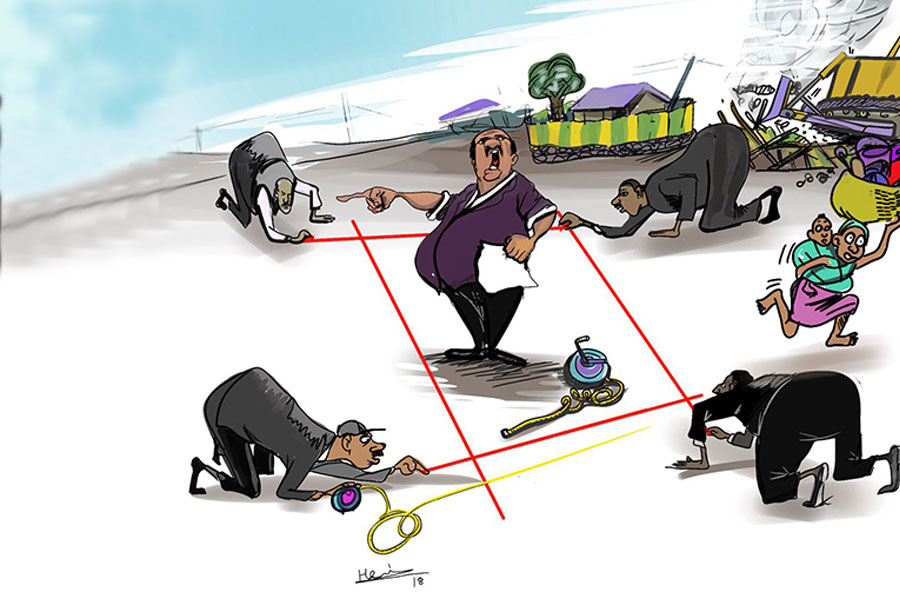
My Opinion | Sep 20,2025
For a few months, I frequently met with a friend at the historic Arada, a neighbourhood around Piassa.
Sunny and buoyant days in the area, with the movie houses, eating places, and pastries, have been in reminiscence. The non-stop mob-like everyday scene in front of the now-under-construction Adwa Museum and the taxi and bus queues that linger into the evenings is a spectacle on its own. It is a sheer contrast to the Sundays and holidays stillness that settles on the likes of the nearby Wawel Street (nearby Lideta Cathedral School).
We explored the neighbourhood’s multi-faceted challenges in our recent meetup. Our visit involved being to some alleys and walking to places we had never been. We stayed late hours to grasp the new realities of the old neighbourhood.
The opening of the historic Hager Fikir Theatre, after an illustrative renovation, and the enthusiasm we drew from the theatre shows, we repeatedly attended to the merriment of the auditorium ushers, who are responsible for checking tickets, and directing patrons to their seats, came handy for the repeated meetups. Sombre has been, at times, the tone of the voices in our discussions. It brought to the nooks and crannies of Arada’s shifting architectural landscape and the loss of much of the original houses along with their architectural and historical value from age through invasion of spaces.
Constant informal structures and settlements caused overcrowding, thus making open spaces hardly available nowadays. They impede movement on narrowed alleys that are the hallmark of the heart of Arada. This place exhibits the majority of the historical houses in the city, years of neglect due to a lack of proper historical background, and run-down buildings through incompatible functional usage. Along with these are significant changes in physical appearances with added partition walls, altered fixtures, and closed balconies.
This all is against the backdrop of an area distinguished by its roofing of buildings of the pre-1900 period. It is a traditionally made roofing decorated underneath with bamboo bound and leather straps, a robust and decorative technique. It is a distinctive feature of their style, compared with domes made of wood and placed at the top of the ridge cap of palaces or residences. A style of a strong façade, entrances rose from the ground level and reached by many stairs, decorative front mainly of Indian origin, and closed and open verandas used for ventilation.
However, as much of the physical feature looks beyond bringing back the diverse street life, the social network from small and narrow frontage cafés and retail stores has a powerful presence, being an economic opportunity for low-income households. It is high time that any initiatives appropriately consider the same in stimulating the once Addis Abeba’s inner-city.
Undoubtedly, Addis Abeba’s recent redevelopment projects experience focused on preparing inner-city centres for developing real estate markets and high-rise buildings for businesses and accommodation. Any endeavour needs to entail terms and conditions that were part and parcel of privatising the historic Taitu Hotel with its historical preservation. The livelihoods are shaping the economic values, and thus, the social identity of the neighbourhood residents looks unlikely to be eliminated or mitigated for a while.
Roadside Khat consumption, tiny kiosks and the alarmingly greater than-ever scene of young sex workers on the streets are a few from the list.
Nightclubs and many of the bars in the area are exposed to awkward high sound levels as though tables are set on dance floors. Some nearly extinct nightclubs never served water or soft drinks with seats close to the sound system. After such an unwelcoming experience, the demolished buildings tell a story about the ever-changing politics of preservation and are often far better than buildings that survived ever could.
Hence, premises in relatively good condition and important historical buildings and artefacts must be preserved. The significant effects of relocation of residents need to be seriously considered, given the ensuing social disruption as a lack of easy access to employment opportunities. Arada is a vibrant epicentre of the city with distinct, diverse characteristics; an important centre of urban and architectural heritage with residents that constitute the mixed-use. It needs to maintain its welcoming tradition to visitors, with an environment modified to current conditions and requirements that allow what it means to live on, not only to inhabitants but also visitors.
PUBLISHED ON
Dec 10,2022 [ VOL
23 , NO
1180]


Dec 22 , 2024 . By TIZITA SHEWAFERAW
Charged with transforming colossal state-owned enterprises into modern and competitiv...

Aug 18 , 2024 . By AKSAH ITALO
Although predictable Yonas Zerihun's job in the ride-hailing service is not immune to...

Jul 28 , 2024 . By TIZITA SHEWAFERAW
Unhabitual, perhaps too many, Samuel Gebreyohannes, 38, used to occasionally enjoy a couple of beers at breakfast. However, he recently swit...

Jul 13 , 2024 . By AKSAH ITALO
Investors who rely on tractors, trucks, and field vehicles for commuting, transporting commodities, and f...

Oct 11 , 2025
Ladislas Farago, a roving Associated Press (AP) correspondent, arrived in Ethiopia in...

Oct 4 , 2025
Eyob Tekalegn (PhD) had been in the Governor's chair for only weeks when, on Septembe...

Sep 27 , 2025
Four years into an experiment with “shock therapy” in education, the national moo...

Sep 20 , 2025
Getachew Reda's return to the national stage was always going to stir attention. Once...